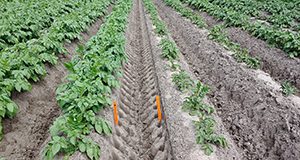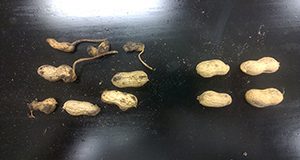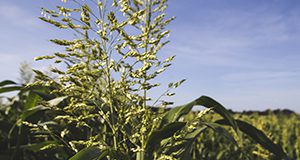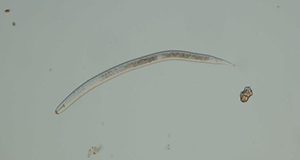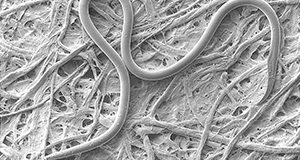Plant-parasitic nematodes are a major pest on potatoes in Florida. Root-knot, sting, and stubby-root nematodes are the primary problems. Sampling is an important component of confirming nematode problems in a field. Nematode management relies heavily on chemical control (nematicides), but crop rotation and soil culture are important considerations as well. This 12-page fact sheet about nematode management in potatoes was written by Zane J. Grabau and J.W. Noling and published by the UF Department of Entomology and Nematology.
http://edis.ifas.ufl.edu/ng029
Tag: Nematode Management
Management of Plant-Parasitic Nematodes in Florida Peanut Production
Nematodes, non-segmented roundworms, can cause serious yield suppression in peanut production. This 10-page fact sheet written by Zane J. Grabau and Donald W. Dickson and published by the UF/IFAS Department of Entomology and Nematology explains how to recognize a potential nematode problem in a peanut production, confirm it with an expert, and choose the best management tools to control the problem.
http://edis.ifas.ufl.edu/in1199
Management of Plant-Parasitic Nematodes in Florida Field Corn Production
This 8-page fact sheet written by Zane J. Grabau and Christopher Vann and published by the Department of Entomology and Nematology explains how corn producers can spot nematode symptoms, sample for nematodes, and manage nematode problems.
http://edis.ifas.ufl.edu/ng014
Management of Plant-Parasitic Nematodes in Florida Soybean Production
This 8-page fact sheet written by Zane J. Grabau and published by the UF Department of Entomology and Nematology in January 2017 explains how to identify and manage a nematode issue in a soybean operation.
http://edis.ifas.ufl.edu/ng018
Fumigant and Non-Fumigant Nematicides Labeled for Agronomic Crops in Florida
Plant-parasitic nematodes can cause severe yield loss of agronomic crops in Florida. Chemical products for managing plant-parasitic nematodes are called nematicides. This three-page facts heet describes the nematicides registered for use in Florida. Written by Zane Grabau and published by the Department of Entomology and Nematology.
http://edis.ifas.ufl.edu/in1152
Sting Nematode Belonolaimus longicaudatus Rau (Nematoda: Tylenchida: Belonolaimidae)
 Among the most destructive plant-parasitic nematodes to a wide range of plants, Belonolaimus longicaudatus damages plant roots. When the plants cannot take up water and nutrients from the soil, they become stunted, wilt, and with severe infestation, die. Florida is considered to be the point-of-origin for Belonolaimus longicaudatus and therefore this nematode exhibits a great deal of diversity in morphology, host preference, and genetics in our region. This 6-page fact sheet was written by W. T. Crow, and published by the UF Department of Entomology and Nematology, March 2015. (Photo W. T. Crow, UF/IFAS)
Among the most destructive plant-parasitic nematodes to a wide range of plants, Belonolaimus longicaudatus damages plant roots. When the plants cannot take up water and nutrients from the soil, they become stunted, wilt, and with severe infestation, die. Florida is considered to be the point-of-origin for Belonolaimus longicaudatus and therefore this nematode exhibits a great deal of diversity in morphology, host preference, and genetics in our region. This 6-page fact sheet was written by W. T. Crow, and published by the UF Department of Entomology and Nematology, March 2015. (Photo W. T. Crow, UF/IFAS)
http://edis.ifas.ufl.edu/in1080
Nematode Management for Golf Courses in Florida (ENY008/IN124)
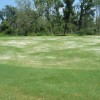 Of all the pests that commonly affect golf course turf in Florida, nematodes are probably the least understood and most difficult to manage. Nematode problems are more common and more severe in Florida than in most other states because our climate and soils provide a perfect habitat for many of the most destructive nematode species. This 8-page fact sheet explains what plant-parasitic nematodes are, how they affect turf, how to tell if they are a problem, and how to manage them. Written by William T. Crow, and published by the UF Department of Entomology and Nematology, January 2013.
Of all the pests that commonly affect golf course turf in Florida, nematodes are probably the least understood and most difficult to manage. Nematode problems are more common and more severe in Florida than in most other states because our climate and soils provide a perfect habitat for many of the most destructive nematode species. This 8-page fact sheet explains what plant-parasitic nematodes are, how they affect turf, how to tell if they are a problem, and how to manage them. Written by William T. Crow, and published by the UF Department of Entomology and Nematology, January 2013.
http://edis.ifas.ufl.edu/in124
Cover Crops for Managing Root-Knot Nematodes (ENY063/IN892)

Root-knot nematodes are widespread and are pests of almost all major crops. Damage can be seen as galls or knot-like swellings produced along plant roots. Cover crops are used to manage nematodes because these microscopic roundworms can move only very short distances on their own and will starve without suitable host plants. This 6-page fact sheet describes several common cover crops that can be used for nematode management. Written by Harsimran K. Gill and Robert McSorley , and published by the UF Department of Entomology and Nematology, July 2011.
http://edis.ifas.ufl.edu/in892
ENY060/IN846 Weed Hosts of Root-Knot Nematodes Common to Florida
ENY060, a 7-page illustrated fact sheet by Jim Rich, Janete Brito, Jay Ferrell, and Ramandeep Kaur, discusses the importance of weeds as nematode hosts, and how knowledge of symptomatic weed hosts can monitor fields for nematodes. Includes references, and a table of selected Florida weeds occurring as hosts of root-knot nematodes. Published by the UF Department of Entomology and Nematology, April 2010.
http://edis.ifas.ufl.edu/in846
